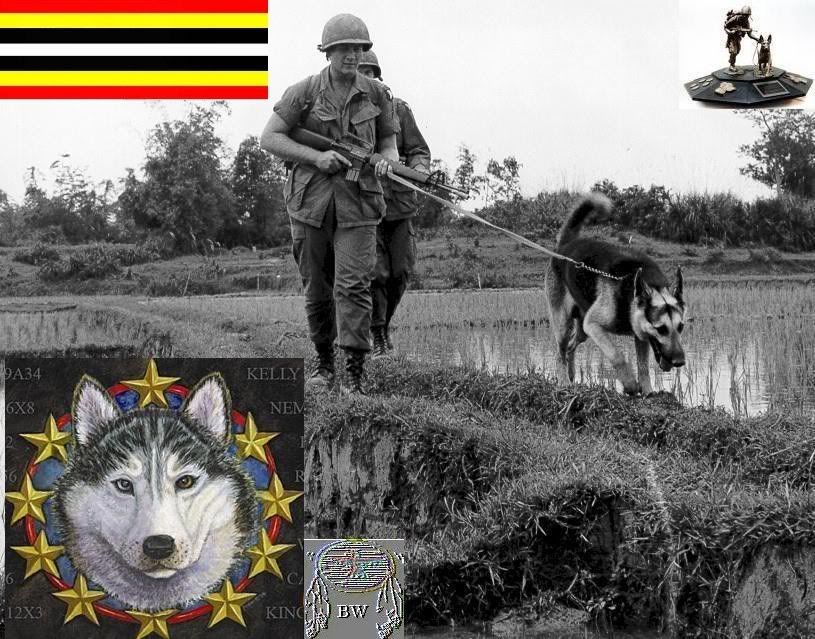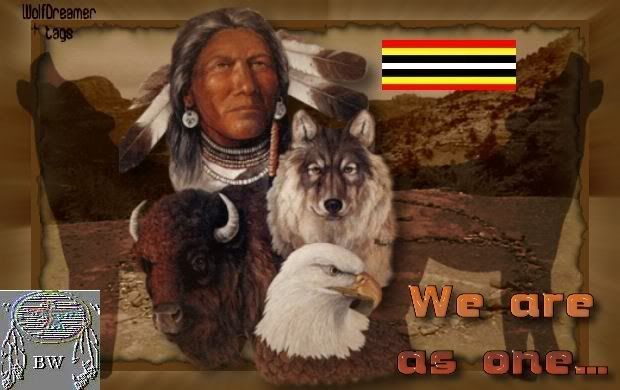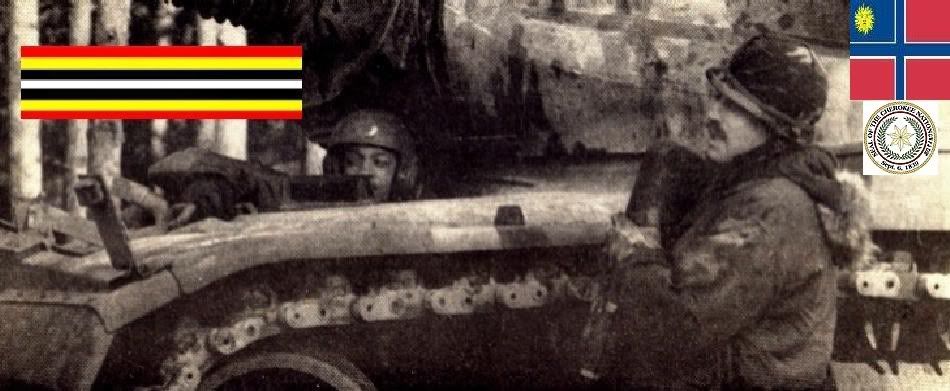|

Scout Dogs in Vietnam
Warriors Citation
In Vietnam, various scout dog platoons were in wide use among infantry units. The 1st Infantry Division was no exception.
They were supported by the 35th at Dian and the 41st Infantry Platoon (Scout Dog) stationed at Lai Khe."The scout dog had
become a lot more popular over here in the last few years," asserted Sergeant Jack C. Russell, training NCO for the 41st platoon.
However, the dogs must come a long way before they could be utilized on ambush patrols and recon-in-force teams by the Big
Red One. Scout dogs differed in both temperament and training from tracking and sentry dogs. Tracker dogs are usually docile
and sentry dogs are trained to kill. The scout dog, under ordinary conditions are neither docile or killers, but well trained,
obedient and alert. For these reasons, particular care went into selecting a dog for scout training. The first phase of training
came at Lackland Air Force Base, Tex. Here the dogs underwent extensive training to determine whether or not they were scout
dog material. First of all, the canine must be in good health, must not weigh less than 60 pounds and be between one and three
years old. If the dog was selected for scout training, he was sent to the Army's Scout Dog Training School at Ft. Benning,
Ga. The selection of handlers for the dogs was as important as the selection of the dogs themselves. Experience had shown
that handlers must have a friendly attitude toward dogs, patience and perseverance, physical endurance and exercise common
sense. At Ft. Benning the dogs underwent 12 weeks of intensive training with these men, who remained with the dogs throughout
the entire cycle. The training was broken down into two parts. Basic obedience, the first phase, took place during the first
two weeks of the training. It was during this period the handler got used to the dog, and the dog used to the handler. From
the start, the warrior must establish himself as the boss or the dog's chances of excelling as a competent scout dog are threatened.
The superiority was sustained by teaching the dog to obey such basic commands as "heel, sit, down, stay and crawl." This was
done by the use of the hand-sign and voice. At the end of two weeks, the second phase of training began; it involved ten
weeks of field instruction. The basic obedience learned during the first two weeks was not entirely forgotten, as the dogs
were continually refreshed on previous commands through-out the cycle. The purpose of the field instruction was to teach the
handler and dog to work as a team in alerting others to enemy presence. Also, the dog was taught to give only a silent warning,
since barking would alert the enemy. During the ten week period, the dog and handler were exposed to every type of condition
they will encounter in the jungle areas of Vietnam. For the first few weeks the dogs were taken on patrols during daylight
hours until they become proficient enough to be introduced to night-time working conditions. During the night training phase,
the handlers learned to place a greater reliance on the dog's abilities. Another phase of the training included three days
spent in a simulated Viet Cong village. Here the dogs were able to operate under the same conditions they would find in a
real enemy village. The final step of specialized training came in the eleventh week. Each team went through an Operational
Readiness Test (ORT), where they were subjected to simulated combat conditions. They were required to demonstrate their proficiency
in overcoming natural obstacles, scouting rice paddies, swamps, caves and tunnels, working from a boat, and scouting through
villages and jungles. Each team were graded by a qualified instructor during ORT to determine if the dog or handler needed
additional training. In a few cases some dogs had to be recycled. The final decision was left up to the chief instructor,
who after conferring with his other instructors, decided who made the grade and who didn't. All of the instructors were qualified
dog handlers themselves, and had spent a tour of duty in Vietnam as a scout dog handler. Bien Hoa Air Base was the next stop
for both handler and dog.

In most cases the two do not come to Bien Hoa together, unless it was a unit move. The reason for this is that some dogs have
to stay behind for additional training. Also, there are already dogs in-country waiting for handlers. When the handlers reached
Bien Hoa they receive another dog, which will be theirs for the rest of their Vietnam tour. Many seemed to think a dog would
not listen to the commands of a new handler, but this was not the case with competent scout dogs. After two weeks of in-country
training at the Air Base, the dog and his new master were old friends, and each knew just what to expect from each other.
The training was a refresher of what was originally accomplished at Ft. Benning, and helped the team adapt more readily to
their environment. From Bien Hoa, the scout dog teams were assigned to a scout dog platoon. Teams designated for the 41st
Infantry Scout Dog Platoon were sent to Lai Khe, where they would assist infantry units of the Big Red One in tactical operations
against hostile forces. They were employed to detect ambush sites and enemy caches of weapons, food and ammunition. After
the teams reach Lai Khe and became settled in their new habitat, they underwent more training to familiarize themselves with
the terrain in which they would be working. This was necessary, because the area around Lai Khe was different from such areas
as the Delta region, where there was a great deal of water." He added the final check is to make sure the dog and handler
were 100 per cent ready to participate in a patrolling activity. Additional drill would be required if they were not. If a
dog picked up an unfamiliar scent while on patrol, he would give an alert, which the handler would pass on to the company
commander or platoon leader. There was no special method by which all dogs alert. Each dog was an individual in his manner
of alerting. Therefore, the handler must observe the dog's behavior carefully so he did not miss its signal of alert. Sergeant
Gordon Moen of Meskegon, Mich., a handler with the scout dog platoon, admitted when his dog "Has So" gave an alert, the dog's
hair would stand up on its back. Another dog called Major had the strange habit of crossing his ears on an alert, while Eric
put on an acrobatic act by walking on his hind legs. "Everytime the dog became alert, the area was checked out for mines,
personnel and boobytraps," said Sergeant Grimes. "These dogs were especially good at detecting ambushes," he added. Such was
the case with Sergeant Jonnie D. Foster of Belhaven, N.C., and his dog Duke. While working as pointmen for Company A, 1st
Battalion, 28th Infantry, the scout team alerted the company just in time to keep the men from walking into an enemy ambush.
Because the dog had acted quickly in alerting First Lieutenant Anthony F. Romans, A Company's commanding officer, the soldiers
were able to take good defensive positions before the unavoidable enemy contact. In a letter of commendation from Lieutenant
Romans, the two were singled out for "clearly demonstrating the high level of proficiency that can be rendered by scout dog
teams." Sergeant Russell pointed out that many times while working in tall grasses, the dogs will jump up above the growth
to get the scent. "A scout dog was not able to distinguish between an enemy force or a weapons cache," he added, "but the
dog gave out with a stronger alert the greater the find." Scout dogs, in many cases, were able to detect the enemy hiding
underwater. If the enemy was using a reed to breathe through, the canine will have little trouble picking up the scent. Whenever
a dog was injured in the field and has to be taken out of action, he was treated much the same way as a human casualty would
be. If the injury was serious and requires surgery, the dog would be taken to the Army Animal Clinic at Ton Son Nhut Air Base
in Saigon where a well-trained veterinarian took over. In most instances, however, a veterinary technician was assigned to
each scout dog platoon. He was able to treat minor illnesses and injuries. The majority of the injury cases could be treated
on the spot, permitting the dog to continue its mission. As with soldiers, medical records of the dogs were also kept up to
date. Most of the animals weighed between 70 and 75 pounds. They were well fed and groomed by their handlers, who had the
full responsibility of caring for the dog. The handlers took care of their dogs 24 hours a day. They did everything but sleep
and eat with them to insure the animals' well-being. As a result of this close association, man and dog became quite attached
to one another. "My dog was the greatest," affirms Sergeant Foster; "he's like a brother." Sergeant Moen explains that every
dog handler felt the same toward his animal. "A dog was as good as a weapon," he said. When the dogs were not in the field
they are usually training, which could involve putting enemy decoys ahead of the dogs for special alert drills. The dog's
high standards were constantly being honed to near perfection. The life of a Scout Dog was a rough one, but as many units
will testify-a scout dog meant the difference between life and death. From: historical accounts & records


LINK TO BRAVEHORSE WARRIORS VOLUME TWO
|

